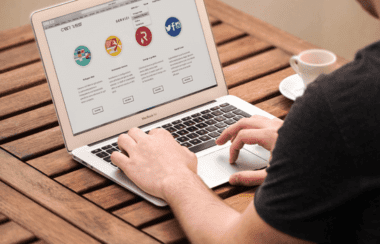How to Start Freelancing With No Experience
By Craig Cannings

Are you ready to take the plunge into freelancing but feel intimidated because of your lack of experience? Don’t worry — many successful entrepreneurs have started their own businesses with no prior knowledge. With a few simple steps, anyone can learn how to start freelancing with no experience and find their first client in no time. Often, it’s those first few steps that will help you find your path and journey toward making your freelancing business a reality.
In this blog post, we’ll share tips on how to define your niche, create an online presence, develop your portfolio, and network with other professionals in your field. And we’ll finish off by discussing how to reach out directly to potential clients. So, let’s get moving on building a freelance career today.
How to Start Freelancing With No Experience: A Quick Guide
STEP 2: Create an Online Presence
STEP 3: Develop Your Portfolio
– Highlight Your Achievements and Accomplishments:
STEP 4: Network with Other Freelancers and Professionals in Your Field
STEP 5: Reach Out to Potential Clients Directly
– Identify Companies That Could Benefit From Your Services or Expertise
– Craft an Engaging Pitch Email That Highlights What You Can Offer Them
– Follow Up With Prospective Clients After Sending Out Pitches
STEP 1: Define Your Niche
It’s essential to define your niche when starting out as a freelancer. Identifying your skills and interests can help you determine what services you’re best suited for and what kind of clients you should be targeting. First, take some time to reflect on the things that come naturally to you, such as writing, design, admin tasks, social media, bookkeeping, or any other skill that could be useful in a freelance capacity. Consider also any hobbies or passions that may give you an edge over competitors in certain areas.
In a previous blog post, “Discover Your Ideal Freelance Career Path in 2023,” we recommend asking yourself three questions:
– What can you draw from the past?
– What can you leverage now in the present?
– Where are you going in the future?
Thinking about your past, present, and future will help you use your experiences, skills, and goals to carve out a fulfilling niche that takes advantage of what you’ve learned along the way. But also remain open to new skills you may not have considered.
We encourage our FreeU students to try a variety of courses, even ones that may be outside their previous experience. Sometimes, they discover new skills and passions they never knew they had.
Next, researching the market is key to understanding which services are currently in demand and how much they typically cost. This will give you an idea of where there might be opportunities for growth within your chosen field and allow you to set competitive rates for yourself. Additionally, it’s important to stay up to date with industry trends so that your skills remain relevant and attractive to potential clients.
For example, you can research profitable niches by consulting statistics portals like Statista or freelance marketplaces like FreeUp, Upwork, or PeoplePerHour. Industry-specific Facebook or Linkedin groups and keyword research tools like Ubersuggest or Mangools can also provide important insights into the popularity of certain services.
Now that you’ve identified your skills and interests, researched the market, and chosen a specialty, it’s time to create an online presence so potential clients can find you.
STEP 2: Create an Online Presence
Creating an online presence is essential for freelancers looking to get their businesses off the ground. Building a professional website is one way of establishing your brand and gaining visibility with potential clients. Your website should include information about your services, a portfolio of work samples, contact information, and any other relevant details that will help you stand out from the competition.
To further explain the purpose of a freelancing website, we interviewed web designer and consultant Barb Henry in an article titled “The Best WordPress Themes for Freelancers in 2023.” She says,
“You want a well-designed website that clearly states what you do and makes it easy for people to find the information they need. A clean website with a clear path to conversion will win every time.”
Establishing social media profiles on platforms like LinkedIn, Twitter, and Instagram can also be beneficial for connecting with potential clients and other professionals in your field. Use these accounts to showcase projects you’ve worked on or highlight accomplishments such as awards or certifications you’ve earned. Post regularly to keep followers engaged and up to date on what you’re working on.
For instance, in the “Optimize Your LinkedIn Profile” course, we recommend using the Featured Content section to showcase samples of work you’ve done. In addition to posting content that shows up in your Activity section, you can also consider doing LinkedIn Live, Audio events or LinkedIn Newsletters to further build your credibility and following.
Joining freelance platforms can also increase exposure for your business by connecting you with companies that are looking for freelancers in your niche. We recommend choosing popular freelance marketplaces like Upwork or PeoplePerHour, where you can apply for projects or post your own. FlexJobs is another great option that lets you choose from a wide range of remote and flexible-schedule jobs.
Many of these sites allow users to create detailed profiles outlining their skillset so clients can easily find them when searching for someone with specific qualifications or experience levels. Consequently, it’s important to fill out all required fields completely and accurately, so clients receive an accurate representation of who they’d be hiring if they choose you for a project.
As you can see, having a strong online presence is essential for any freelancer. By building a professional website, establishing social media profiles, and joining freelance platforms, you can ensure that potential clients find you easily.
Plus, when you start freelancing with no experience, a quality and professional website can really boost your credibility. Now let’s move on to developing your portfolio.
STEP 3: Develop Your Portfolio
Having a portfolio is an essential part of any freelancer’s success. It showcases your work samples, highlights your achievements and accomplishments, and builds trust with potential clients. Here are some tips on how to develop an impressive portfolio that will help you stand out from the competition:
Showcase Your Work Samples:
The best way to demonstrate your skills as a freelancer is by showcasing examples of past projects or work that you have completed. Include links to websites or other digital products you’ve created, screenshots of your designs, articles you’ve written, etc. This will give potential clients an idea of what they can expect when working with you.
Highlight Your Achievements and Accomplishments:
Even if you feel shy about discussing your accomplishments, don’t be afraid to brag about yourself. Show off awards or certifications that prove your expertise in the field.
At Freelance University, we have a variety of skill-specific certifications that our freelance students can display on their website and/or LinkedIn Profile to demonstrate their ongoing professional development.
If possible, also include quotes from satisfied customers who were pleased with the results of their project with you. This will show potential clients that others have been happy with your services before them and encourage them to hire you for their own project needs.
In addition, ask previous employers or clients if they’d be willing to provide a testimonial for your portfolio page on their experience working with you in the past. These can go a long way toward building trust between you and new prospects looking for someone reliable enough for their project needs. Finally, be sure to thank those who provide these testimonials, as it could even lead to future collaborations down the line.
Developing your portfolio is an essential step in starting a successful freelance career. Now that you have the tools to showcase your work, it’s time to build relationships and expand your network with potential clients and other professionals in your field.
STEP 4: Network with Other Freelancers and Professionals
Networking is an essential part of freelancing, especially for those who are just starting out. It’s a great way to get your name out there so you can find potential clients.
To network effectively, first, consider attending events and conferences related to your industry or niche area of expertise. This will give you the opportunity to meet other professionals in your field and build relationships with them that could lead to future collaborations or referrals.
You’re not alone if you feel nervous or shy about mingling with potential clients at events. Many of us share these concerns. We may even be fearful. But there are ways you can cope with this anxiety, as we discuss in our previous blog post, “An Introvert’s Guide to Networking like a Rock Star.”
For example, you can research the venue and event schedule ahead of time so you know what to expect. And we also recommend preparing a 20- to 30-second elevator speech that shares who you are and how you help others with your freelancing business.
Next, join professional organizations and associations related to your field of work or interests so you can connect with more potential clients. These groups provide valuable resources such as job postings, networking opportunities, and mentorship programs that can help you grow professionally. Additionally, they often host webinars or workshops on topics relevant to freelancers. By attending those events, you can stay up to date on the latest trends in the industry.
And finally, don’t forget about social media. Connecting with people who share similar goals as you do is key when it comes to building relationships within the freelance community. Follow influencers in your niche area of expertise so you can stay informed about what’s going on in the industry while also getting inspiration from their success stories. You may even find yourself collaborating with them in the future.
Ultimately, networking with other freelancers and professionals in your field is an invaluable resource for learning new skills, finding potential clients, and growing your business. Now that you’ve established connections, it’s time to start reaching out directly to potential clients.
STEP 5: Reach Out to Potential Clients Directly
Reaching out to potential clients directly is a great way to find new business opportunities and grow your freelance career. To get the best results, you need to identify companies that could benefit from your services or expertise, craft an engaging pitch email highlighting what you can offer them, and follow up after sending out pitches.
Identify Companies That Could Benefit From Your Services or Expertise
Before you start reaching out to potential clients, it’s important to do some research on the types of businesses that could use your skills and services. Take time to think about what industries would be most likely interested in hiring someone with your experience and qualifications.
Once you’ve identified a few target markets, create a list of companies within those industries that may be looking for freelancers like you. You can also look at job postings online or ask around in professional networks for leads who might be looking for help with certain projects. A perfect place to research and find ideal clients is through LinkedIn Search!
Craft an Engaging Pitch Email That Highlights What You Can Offer Them
Once you’ve identified some potential clients, it’s time to craft an engaging pitch email outlining why they should hire you as their freelancer. Make sure the email is personalized so it stands out from other generic messages they may receive from other applicants.
Include information about how your skills and experience make you uniquely qualified for the project they’re working on as well as any relevant success stories or accomplishments that demonstrate why they should choose you over others vying for the same opportunity.
Follow Up With Prospective Clients After Sending Out Pitches
Finally, don’t forget to follow up after sending out pitches. This shows initiative and demonstrates that you’re serious about getting hired by a certain company or clientele base. Send polite reminder emails if necessary, but don’t become too pushy. Instead, focus on providing additional information if needed. For example, portfolio samples or references from past employers or clients will further prove why hiring you is beneficial for them.
Above all, don’t get discouraged. In an article titled “New To Freelancing? 16 Tips For Landing Your First Client,” Erin Miller recommends scheduling frequent conversations with potential clients and explains,
It’s not about what you can do for the client; it’s about listening, uncovering their pain points and offering solutions. Even if an initial conversation doesn’t lead to an immediate client, when you add value, people will remember. Nine times out of 10, they will seek you out down the road.
Starting freelancing with no experience can be intimidating, but it doesn’t have to be!
With the right steps and a little bit of effort, you can find your first client in no time. Define your niche, create an online presence, develop your portfolio, network with other professionals in your field, and reach out to potential clients directly — these are all essential steps that will help you get started on the path to becoming a successful freelancer.
And don’t forget that there’s plenty of support available from experienced freelancers who can offer advice and guidance as you begin this exciting journey. We wish you all the best in your search and are here to support you along the way!
Do you have a better idea now about how to start freelancing with no experience, but could use some extra support? Freelance University is here to help! Our full-service freelance community provides courses, resources, and support so that you can get the skills necessary to become a successful freelancer.
With our step-by-step guidance, you’ll be able to find clients and remote work in no time. Join us today and take your career into your own hands!









































































































